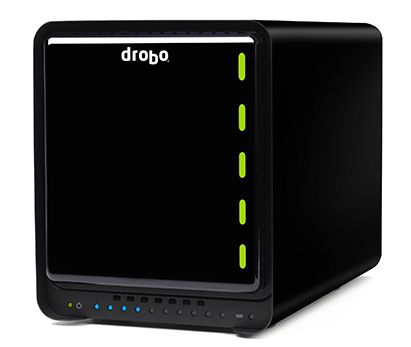CES: Data Robotics Drobo S

With Microsoft's next generation Home Server dropping support for its storage fabric technology, Data Robotics' Drobo offers an alternative approach to building large amounts of storage using mis-matched disks. Unlike traditional RAID arrays which require all the disks used to be identical in size, Drobo's BeyondRAID storage array allows you to increase the amount of storage in an array each time you add or replace a pair of larger disks. There's no need to worry about matching disk manufacturers, sizes, or even speeds; the Drobo S handles all that for you.
The latest version of Data Robotics' directly attached storage array, the Drobo S, speeds up connections by adding USB 3.0 support, and the ability to have up to 10TB of storage in five drive bays (7.3TB of protected data). You can switch between single or dual drive redundancy on the fly and all drives are hot-swappable, so you can recover from a disk failure or upgrade storage capacity without any down time. While dropping back to single disk redundancy from dual gives you extra space, you can also chain Drobo arrays together for additional storage capacity, up to a total of 32TB.
One useful feature is described by Data Robotics as "self-healing". When it's idle, the Drobo will inspect drives, marking problem areas to ensure data is only stored on reliable blocks and sectors. This approach works alongside the Drobo S's redundant storage, reducing the risks to your data even further.
USB 3.0 isn’t the only connection option: the Drobo S also supports eSATA and FireWire 800 connections, with the array's USB 3.0 port backward compatible with USB 2.0. The USB 3.0 option gives you additional speed, with transfer speeds up to 50% higher than FireWire 800, making it suitable for working with the largest files and as a high speed backup device. There's also support for most of the common filesystems in use, so you can connect the Drobo S to a Mac OS X device using HFS+, to a Windows PC or Server using NTFS or FAT32, and to a Linux machine using Ext3.
Increased business regulation means a need for increased storage, and the ever-expanding amount of data in our businesses means that storage demands are only going to increase (Molly Rector of tape array company SpectraLogic used the recent Storage Visions conference to point out massive growth in the storage requirements for unstructured data, from 161 Exabytes created in 2009 to 1.2 Zetabytes in 2011). Reliable, easy to manage storage is increasingly important, and devices like the Drobo S are going to become essential business tools very quickly.
Simon Bisson
